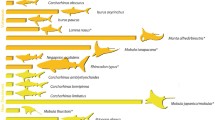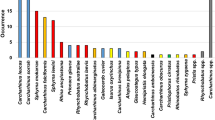Abstract
The shark and ray (Elasmobranchii) trade is a commercially valuable industry that has negative consequences for wild populations. An estimated 100 million sharks are caught each year to supply the demand for cultural cuisines, traditions and practices, including shark fin soup and Traditional Chinese Medicine. Despite the establishment of frameworks and regulations by international trade and conservation bodies as well as national legislations, elasmobranch populations continue to decline. While their conservation becomes an ever more pressing concern, a major obstacle that hampers regulation is the mislabelling and/or misidentification of dried products or carcasses that have had fins removed. Here we use DNA barcoding to identify the species of origin for a variety of shark and ray products readily available to consumers in Singapore, a major importer of these goods. We amplified a fragment of the cytochrome c oxidase subunit I gene from shark fin, cartilage and meat, as well as ray gill plates and meat for DNA sequencing. Our analysis of 207 DNA barcodes yielded 28 positively identified elasmobranch species, eight of which are listed under Appendix II of the Convention on International Trade in Endangered Species of Wild Fauna and Flora, and 12 are listed as Endangered or Vulnerable by the International Union for the Conservation of Nature. This information will be useful to regulatory bodies in controlling trade and establishing new or revisiting previous conservation status listings.
Similar content being viewed by others
References
Alves RNN, Rosa IL, Albuquerque UP, Cunningham AB (2013) Medicine from the wild: an overview of the use and trade of animal products in traditional medicines. In: Alves RNN, Rosa IL (eds) Animals in traditional folk medicine: implications for conservation, Springer, Berlin, pp 25–42. https://doi.org/10.1007/978-3-642-29026-8_3
Armani A, Giusti A, Guardone L, Gianfaldoni D, Guidi A (2016) Universal primers used for species identification of foodstuff of animal origin: effects of oligonucleotide tails on PCR amplification and sequencing performance. Food Anal Methods 9:1199–1209. https://doi.org/10.1007/s12161-015-0301-9
Asis AMJM, Lacsamana JKM, Santos MD (2014) Illegal trade of regulated and protected aquatic species in the Philippines detected by DNA barcoding. Mitochondrial DNA 27:659–666. https://doi.org/10.3109/19401736.2014.913138
Barbuto M, Galimberti A, Ferri E, Labra M, Malandra R, Galli P, Casiragh M (2010) DNA barcoding reveals fraudulent substitutions in shark seafood products: the Italian case of ‘‘palombo” (Mustelus spp.). Food Res Int 43:376–381. https://doi.org/10.1016/j.foodres.2009.10.009
Bonfil R (1994) Overview of world elasmobranch fisheries. Fisheries Technical Paper 341. Food and Agriculture Organisation, Rome. http://www.fao.org/docrep/003/v3210e/v3210e00.htm. Accessed 09 April 2018
Boon PY (2017) The shark and ray trade in Singapore. TRAFFIC, Southeast Asia Regional Office, Petaling Jaya. http://www.traffic.org/publications/the-shark-and-ray-trade-in-singapore.html. Accessed 09 April 2018
Bornatowski H, Braga RR, Vituleb JRS (2014) Threats to sharks in a developing country: the need for effective simple conservation measures. Nat Conserv 12:11–18. https://doi.org/10.4322/natcon.2014.003
Bullen E, Mann BQ (2003) Sedgwick’s/ORI/WWF Tagging programme: giant guitarfish (Rhynchobatus djiddensis). Data report, Oceanographic Research Institute 2003/2
CITES (2018) https://www.cites.org/eng/disc/how.php. Accessed 17 March 2018
Clarke S, Milner-Gulland EJ, Bjørndal T (2007) Social, economic, and regulatory drivers of the shark fin trade. Mar Resour Econ 22:305–327
Compagno LJV, Last PR (1999) Rhinidae (Rhynchobatidae). Wedgefishes. In: Carpenter KE, Niem V (eds) FAO identification guide for fishery purposes. The living marine resources of the western central pacific. FAO, Rome, pp 1418–1422
Cripps G, Harris A, Humber F, Harding S, Thomas T (2015) A preliminary value chain analysis of shark fisheries in Madagascar. Indian Ocean Commission report IOTC-WPEB11-17. http://www.fao.org/3/a-az400e.pdf. Accessed 16 April 2018
Davidson LNK, Dulvy NK (2017) Global marine protected areas to prevent extinctions. Nat Ecol Evol 1:0040. https://doi.org/10.1038/s41559-016-0040
Dent F, Clarke S (2015) State of the global market for shark products. FAO Fisheries and Aquaculture Technical Paper No. 590. FAO, Rome. p 187. http://www.fao.org/3/a-i4795e.pdf. Accessed 09 April 2018
Dudley SFJ, Cavanagh RD (2006) Rhynchobatus djiddensis. The IUCN Red List of threatened species 2006: e.T39394A10197912. Accessed 09 April 2018
Dulvy NK, Fowler SL, Musick JA, Cavanagh RD, Kyne PM, Harrison LR, Carlson JK, Davidson LNK, Fordham SV, Francis MP, Pollock CM, Simpfendorfer CA, Burgess GH, Carpenter KE, Compagno LJV, Ebert DA, Gibson C, Heupel MR, Livingstone SR, Sanciangco JC, Stevens JD, Valenti S, White WT (2014) Extinction risk and conservation of the world’s shark sand rays. eLife 3:e00590. https://doi.org/10.7554/eLife.00590
Espinosa H, Lambarri C, Martínez A, Jiménez A (2015) A case study of the forensic application of DNA Barcoding to sharkfin identification in the Mexican Pacific. DNA Barcodes 3:94–97. https://doi.org/10.1515/dna-2015-0012
Fields AT, Fischer GA, Shea SKH, Zhang H, Abercrombie DL, Feldheim KA, Babcock EA, Chapman DD (2017) Species composition of the international shark fin trade assessed through a retail-market survey in Hong Kong. Conserv Biol 32:376–389. https://doi.org/10.1111/cobi.13043
Griffiths AM, Miller DD, Egan A, Fox J, Greenfield A, Mariani S (2013) DNA barcoding unveils skate (Chondrichthyes: Rajidae) species diversity in ‘ray’ products sold across Ireland and the UK. PeerJ. https://doi.org/10.7717/peerj.129
Hebert PD, Cywinska A, Ball SL (2003) Biological identifications through DNA barcodes. Proc R Soc Lond Ser B 270:313–321. https://doi.org/10.1098/rspb.2002.2218
Holmes BH, Steinke D, Ward DR (2009) Identification of shark and ray fins using DNA barcoding. Fish Res 95:280–288. https://doi.org/10.1016/j.fishres.2008.09.036
Huffman JE, Wallace JR (2012) Wildlife forensics: methods and applications, 1st edn. Wiley, New York. https://doi.org/10.1002/9781119953142.index
IUCN Shark Specialist Group (2014) https://www.iucn.org/sites/dev/files/import/downloads/fact_sheets.pdf. Accessed 17 May 2018
Ivanova NV, Zemlak TS, Hanner RH, Hebert PD (2007) Universal primer cocktails for fish DNA barcoding. Mol Ecol Notes 7:544–548. https://doi.org/10.1111/j.1471-8286.2007.01748.x
Jackson JBC, Kirby MX, Berger WH, Bjorndal KA, Botsford LW, Bourque BJ, Bradbury RH, Cooke R, Erlandson J, Estes JA et al (2001) Historical overfishing and the recent collapse of coastal ecosystems. Science 293:629–638. https://doi.org/10.1126/science.1059199
Kashiwagi T, Marshall AD, Bennett MB, Ovenden JR (2011) Habitat segregation and mosaic sympatry of the two species of manta ray in the Indian and Pacific Oceans: Manta alfredi and M. birostris. Mar Biodivers Rec 4:e53. https://doi.org/10.1017/S1755267211000479
Kearse M, Moir R, Wilson A, Stones-Havas S, Cheung M, Sturrock S, Buxton S, Cooper A, Markowitz S, Duran C, Thierer T, Ashton B, Mentjies P, Drummond A (2012) Geneious basic: an integrated and extendable desktop software platform for the organization and analysis of sequence data. Bioinformatics 28:647–1649. https://doi.org/10.1093/bioinformatics/bts199
Leray M, Yang JY, Meyer CP, Mills SC, Agudelo N, Ranwez V, Boehm JT, Machida RJ (2013) A new versatile primer set targeting a short fragment of the mitochondrial COI region for metabarcoding metazoan diversity: application for characterizing coral reef fish gut contents. Front Zool 10:34. https://doi.org/10.1186/1742-9994-10-34
Lis JA, Lis B (2011) Is accurate taxon identification important for molecular studies? Several cases of faux pas in pentatomoid bugs (Hemiptera: Heteroptera: Pentatomoidea). Zootaxa 2932:47–50
Lis JA, Lis B, Ziaja LD (2016) In BOLD we trust? A commentary on the reliability of specimen identification for DNA barcoding: a case study on burrower bugs (Hemiptera: Heteroptera: Cydnidae). Zootaxa 4114:83–86. https://doi.org/10.11646/zootaxa.4114.1.6
Lobo J, Costa PM, Teixeira MA, Ferreira MS, Costa MH, Costa FO (2013) Enhanced primers for amplification of DNA barcodes from a broad range of marine metazoans. BMC Ecol 13:34. https://doi.org/10.1186/1472-6785-13-34
Marko PB, Nance HA, van den Hurk P (2014) Seafood substitutions obscure patterns of mercury contamination in Patagonian toothfish (Dissostichus eleginoides) or “Chilean Sea Bass”. PLoS ONE 9:e104140. https://doi.org/10.1371/journal.pone.0104140
Marshall AD, Compagno LJV, Bennett MB (2009) Redescription of genus Manta with resurrection of Manta alfredi (Krefft, 1868) (Chondrichthyes, Myliobatoidei, Mobulidae). Zootaxa 2301:1–28. https://doi.org/10.5281/zenodo.19173
Martin AP, Naylor GJ, Palumbi SR (1992) Rates of mitochondrial DNA evolution in sharks are slow compared with mammals. Nature 357:152–155. https://doi.org/10.1038/357153a010.1038/357153a0
Moore ABM (2017) Are guitarfishes the next sawfishes? Extinction risk and an urgent call for conservation action. Endangered Species Res 34:75–88. https://doi.org/10.3354/esr00830
Myers RA, Worm B (2003) Rapid worldwide depletion of predatory fish communities. Nature 423:280–283. https://doi.org/10.1038/nature01610
O’Bryhim JR, Parsons ECM, Lance SL (2017) Forensic species identification of elasmobranch products sold in Costa Rican markets. Fish Res 186:144–150. https://doi.org/10.1016/j.fishres.2016.08.020
Oliver S, Braccini M, Newnan SJ, Harvey ES (2015) Global pattern in the bycatch of sharks and rays. Mar Policy 54:86–97. https://doi.org/10.1016/j.marpol.2014.12.017
Ratnasingham S, Hebert PDN (2007) BOLD: the barcode of life data system (www.barcodinglife.org). Mol Ecol Notes 7:355–364. https://doi.org/10.1111/j.1471-8286.2006.01678.x
Robbins WD, Mizue H, Connolly SR, Howard Choat J (2006) Ongoing collapse of coral-reef shark populations. Curr Biol 23:2314–2319. https://doi.org/10.1016/j.cub.2006.09.044
Sembiring A, Pertiwi NPD, Mahardini A, Wulandari R, Kurniasih EM, Kuncoro AW, Cahyani NKD, Anggoro AW, Ulfa M, Madduppa H, Carpenter KE, Barber PH, Mahardika GN (2015) DNA barcoding reveals targeted fisheries for endangered sharks in Indonesia. Fish Res 164:130–134. https://doi.org/10.1016/j.fishres.2014.11.003
Shivji M, Clarke S, Pank M, Natanson L, Kohler N, Stanhope M (2002) Genetic identification of pelagic shark body parts for conservation and trade monitoring. Conserv Biol 16:1036–1047. https://doi.org/10.1046/j.1523-1739.2002.01188.x
Steinke D, Bernard AM, Horn RL, Hilton P, Hanner R, Shivji MS (2017) DNA analysis of traded shark fins and mobulid gill plates reveals a high proportion of species of conservation concern. Sci Rep 7:9505. https://doi.org/10.1038/s41598-017-10123-5
Still J (2003) Use of animal products in traditional Chinese medicine: environmental impact and health hazards. Complement Ther Med 11:118–122. https://doi.org/10.1016/S0965-2299(03)00055-4
Whitcraft S, O’Malley MP, Hilton P (2014) The continuing threat to manta and mobula rays: 2013–2014 market surveys, Guangzhou, China. WildAid, San Francisco, CA. http://wildaid.org/wp-content/uploads/2017/09/The-Continuing-Threat-to-Manta-Mobula-Rays_2013-14-Report_FINAL.pdf. Accessed 27 April 2018
White WT, Clark TB, Smith WD, Bizzarro J (2006) Mobula japanica. In IUCN 2011. IUCN Red List of threatened species. Version 2011.2. http://www.iucnredlist.org/details/41833/0. Accessed 14 April 2018
Worm B, Davis B, Kettemer L, Ward-Paige CA, Chapman D, Heithaus MR, Kessel ST, Gruber SH (2013) Global catches, exploitation rates, and rebuilding options for sharks. Mar Policy 40:194–204. https://doi.org/10.1016/j.marpol.2012.12.034
Zeng Y, Wu Z, Zhang C, Meng Z, Jiang Z, Zhang J (2016) DNA barcoding of mobulid ray gill rakers for implementing CITES on elasmobranch in China. Sci Rep 6:37567. https://doi.org/10.1038/srep37567
Acknowledgements
Funding was generously provided by the Singapore Ministry of Education Academic Research Fund Tier 1 (R-154-000-A63-114) and the National Research Foundation, Prime Minister’s Office, Singapore under its Marine Science R&D Programme (MSRDP-P03). Financial support from the Wildlife Conservation Society is gratefully acknowledged.
Author information
Authors and Affiliations
Corresponding author
Electronic supplementary material
Below is the link to the electronic supplementary material.
Rights and permissions
About this article
Cite this article
Wainwright, B.J., Ip, Y.C.A., Neo, M.L. et al. DNA barcoding of traded shark fins, meat and mobulid gill plates in Singapore uncovers numerous threatened species. Conserv Genet 19, 1393–1399 (2018). https://doi.org/10.1007/s10592-018-1108-1
Received:
Accepted:
Published:
Issue Date:
DOI: https://doi.org/10.1007/s10592-018-1108-1




